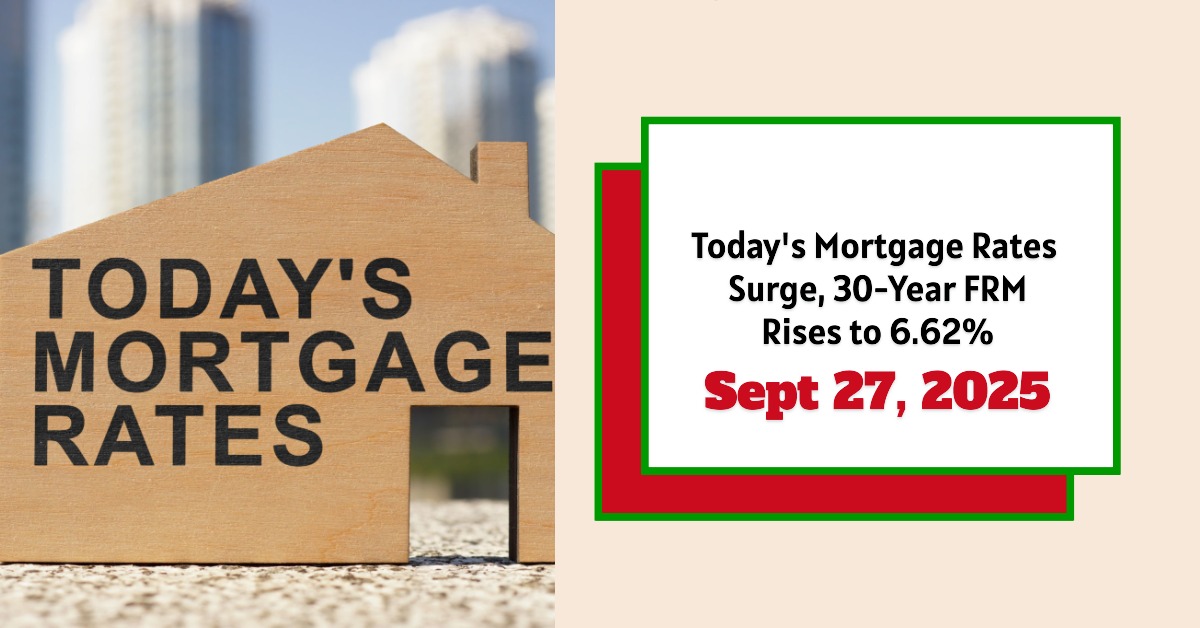Mortgage rates today, September 27, 2025, are notably higher compared to last week, with the average 30-year fixed mortgage rate climbing to 6.62%, up by 15 basis points from 6.47%. This rise signals a continued trend of increased borrowing costs for homebuyers and refinancers alike.
While the 15-year fixed mortgage rate dipped slightly to 5.70%, the overall picture shows an uptick, especially in 30-year fixed and refinance rates. According to Zillow’s latest data, refinancing costs have surged with the 30-year fixed refinance rate nearing 7.12%, up 36 basis points week-over-week. This increase affects affordability, market activity, and strategies for both buying and refinancing a home.
Today's Mortgage Rates – September 27, 2025: Rates Surge Across all Home Loan Types
Key Takeaways
- 30-year fixed mortgage rates rose to 6.62%, an increase from last week’s 6.47%.
- 15-year fixed mortgage rates edged down slightly to 5.70%.
- Refinance rates surged, with the 30-year fixed refinance rate at 7.12%, up 36 basis points.
- Government-backed mortgage rates (FHA and VA loans) also increased, notably FHA fixed loans rising to 7.23%.
- The Federal Reserve’s recent rate cut impacted Treasury yields but mortgage rates remain elevated due to wider spreads.
- Market forecasts predict mortgage rates averaging around 6.4% late 2025, potentially dipping in 2026 if inflation eases and spreads narrow.
Understanding Mortgage Rates Today: September 27, 2025
Today's mortgage rates reflect a complex interaction of economic forces. The key driver remains the 10-year U.S. Treasury yield, currently around 4.176%, which lenders use as a benchmark to price mortgages. However, mortgage rates do not move in lockstep with Treasury yields. Instead, they are typically 1 to 2 percentage points higher, compensating investors for additional risk compared to risk-free government bonds.
Over the past week, even though the Fed’s benchmark rate cut (from 4.25%-4.5% to 4.0%-4.25%) aimed to loosen borrowing costs, mortgage rates have not dropped as sharply due to a stubbornly wide mortgage-Treasury spread—meaning lenders still demand a premium, which keeps mortgage rates elevated despite lower Treasury yields.
Detailed Overview of Current Mortgage Rates
Zillow’s updated numbers from September 26 show the following for conforming and government loans across various term lengths:
| Loan Type | Current Rate | Weekly Change | APR | Weekly APR Change |
|---|---|---|---|---|
| 30-Year Fixed (Conforming) | 6.62% | +0.15% | 7.07% | +0.16% |
| 15-Year Fixed (Conforming) | 5.70% | -0.05% | 6.00% | +0.06% |
| 20-Year Fixed (Conforming) | 6.21% | +0.13% | 6.47% | -0.02% |
| 5-Year ARM (Conforming) | 7.01% | -0.19% | 7.73% | -0.13% |
| 30-Year Fixed FHA | 7.23% | +1.54% | 8.27% | +1.57% |
| 30-Year Fixed VA | 6.00% | +0.03% | 6.11% | -0.03% |
| 15-Year Fixed FHA | 5.37% | +0.09% | 6.33% | +0.09% |
| 15-Year Fixed VA | 5.75% | +0.07% | 6.10% | +0.15% |
All data as of September 27, 2025, sourced from Zillow.
Refinance Rates Surge: What Borrowers Need to Know
Refinancing has become more costly this week, with the national average 30-year fixed refinance rate increasing to 7.12% from 6.76% a week earlier—an increase of 36 basis points. The 15-year fixed refinance rate also ticked up slightly to 6.01%. However, the 5-year ARM refinance rate softened a tiny bit to 7.41%.
This rise in refinance rates occurs despite the Federal Reserve’s recent rate cut. Why? Because mortgage rates incorporate broader market risk assessments and investor sentiment, which means they are slower to react and may even move independently of benchmark rates and yields.
Mortgage Rate Impact Illustrated: Example Calculations
To highlight how rate changes affect monthly payments, consider a $300,000 home loan:
| Term | Rate (%) | Monthly Payment (Principal & Interest) |
|---|---|---|
| 30-year fixed at 6.47% | 6.47% | $1,893 |
| 30-year fixed at 6.62% | 6.62% | $1,927 |
The dollar difference may seem small, about $34 more per month, but over 30 years, that adds up to over $12,000 in additional interest paid.
For refinancing, someone rolling an old mortgage at 6.5% to the current 7.12% rate would see a payment increase rather than a decrease, highlighting why borrowers are cautious—waiting for rates to potentially drop before locking in a refinance.
The Role of the Federal Reserve and Treasury Yields in Today’s Mortgage Rates
The Fed’s September 17 decision to cut its benchmark rate by 0.25 percentage points was aimed at easing borrowing costs amid solid economic growth (GDP up 3.8% in Q2) and inflation still above target (core PCE at 2.9%). Although this move generally supports lower rates, the actual mortgage market is complicated by the spread between Treasury yields and mortgage rates.
The spread is influenced by:
- Risk premium lenders require over safe Treasury investments.
- Market volatility which has widened spreads recently.
- Investor demand for mortgage-backed securities, which fluctuates.
As the 10-year Treasury yield sits around 4.176%, and the spread remains over 2 percentage points, mortgage rates are pressured upwards despite the Fed’s easing policy.
What Are Experts Saying? Forecast and Market Outlook
The National Association of REALTORS® expects mortgage rates to average 6.4% in the latter half of 2025, dipping further to 6.1% in 2026 if inflation eases and spreads normalize. This forecast reflects cautious optimism that rates won’t escalate much further but won’t drop sharply either.
Similarly, Fannie Mae projects 2025 mortgage rates ending at about 6.4%, with a slight decrease to 5.9% in 2026. They expect refinance activity to increase moderately next year as rates potentially improve.
On the other hand, the Mortgage Bankers Association anticipates some volatility, with rates hovering around 6.7% by year-end and easing to 6.5% in 2026, but with intermittent spikes due to market conditions.
A Closer Look at Government-Backed Loan Rate Changes
Government loans often offer competitive rates for borrowers who qualify. However, we see significant movement this week:
- FHA 30-year fixed spiked sharply by 1.54% to 7.23%. This is a notable jump compared to conforming loan rates and may reflect increased risk premiums lenders are placing on these loans.
- VA 30-year fixed remained more stable, inching up slightly to 6.00%.
- Shorter-term government loans, like 15-year FHA and VA loans, also increased modestly.
These changes impact veterans and first-time buyers who traditionally rely on government loans for more affordable options.
Borrower Considerations in the Current Rate Environment
Facing higher rates, buyers and refinancers are challenged by increased costs. Those locked into old loans below 6% are weighing the benefits of refinancing carefully, especially with refinance rates now above 7%. However, some homeowners with rates above 6.5% might find opportunities if they can secure comparable or lower rates through refinancing.
The wider mortgage-Treasury spread suggests lenders are cautious, reflecting nervousness about inflation persistence and economic factors. This environment requires borrowers to shop wisely and consider how rate moves align with their financial goals.
Related Topics:
Mortgage Rates Trends as of September 26, 2025
Mortgage Rates Predictions Next 90 Days: August to October 2025
Mortgage Rate Summary Table for September 27, 2025
| Loan Type | Current Rate | 1W Change | Refinance Rate | 1W Change (Refi) |
|---|---|---|---|---|
| 30-Year Fixed (Conforming) | 6.62% | +0.15% | 7.12% | +0.36% |
| 15-Year Fixed (Conforming) | 5.70% | -0.05% | 6.01% | +0.04% |
| 5-Year ARM (Conforming) | 7.01% | -0.19% | 7.41% | -0.01% |
| 30-Year Fixed FHA | 7.23% | +1.54% | — | — |
| 30-Year Fixed VA | 6.00% | +0.03% | — | — |
Expert Perspective: Navigating the Mortgage Market Now
From my experience, mortgage markets today show signs of correlation but not synchronization with Fed policy and Treasury yields. This “lag and spread” behavior is typical during periods when inflation remains above target and the economy grows moderately. I believe the persistence of a wide spread indicates that lenders and investors are pricing in uncertainties—whether related to inflation returning or economic shocks—making mortgage rates more resistant to moves in Treasury yields alone.
Overall, we are in a phase where mortgage rates are elevated but could stabilize or moderately decline if inflation trends improve, the Fed eases further, and spreads narrow. Homebuyers and refinancers should keep a close eye on these dynamics.
Capitalize Amid Rising Mortgage Rates
With mortgage rates expected to remain high in 2025, it’s more important than ever to focus on strategic real estate investments that offer stability and passive income.
Norada delivers turnkey rental properties in resilient markets—helping you build steady cash flow and protect your wealth from borrowing cost volatility.
HOT NEW LISTINGS JUST ADDED!
Speak with a seasoned Norada investment counselor today (No Obligation):
(800) 611‑3060
Also Read:
- Will Mortgage Rates Go Down in 2025: Morgan Stanley's Forecast
- Mortgage Rate Predictions 2025 from 4 Leading Housing Experts
- Mortgage Rate Predictions for the Next 3 Years: 2026, 2027, 2028
- 30-Year Fixed Mortgage Rate Forecast for the Next 5 Years
- 15-Year Fixed Mortgage Rate Predictions for Next 5 Years: 2025-2029
- Will Mortgage Rates Ever Be 3% Again in the Future?
- Mortgage Rates Predictions for Next 2 Years
- Mortgage Rate Predictions for Next 5 Years
- Mortgage Rate Predictions: Why 2% and 3% Rates are Out of Reach
- How Lower Mortgage Rates Can Save You Thousands?
- How to Get a Low Mortgage Interest Rate?
- Will Mortgage Rates Ever Be 4% Again?



